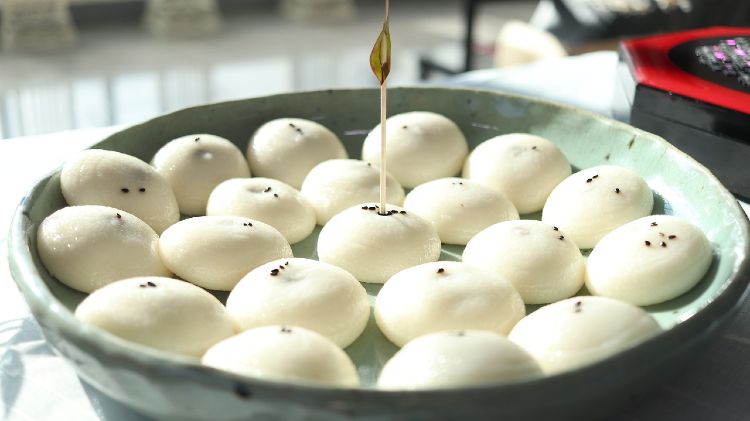Tropical Spices and Fruit Across Grenada
Visiting Grenada recently we saw previously unknown plants and spices growing in their natural habitat and, equally importantly for food lovers, we had the opportunity to experience many new tastes and flavours.
Our day invariably began with glasses of pure fruit juice and plates of fresh fruit enjoyed on our terrace overlooking the turquoise sea. Some of the fruits were familiar to us: pineapple, coconut, mango, water melon and banana. The taste of these naturally-ripened fruits plucked from the trees maybe a couple of days previously was quite different from what we are used to buying in Britain. Here the common banana was silky- textured and bursting with a sweet flavour never found in the rock hard, artificially (but inadequately) ripened items available in our shops.
There were other fruits which we had tasted occasionally such as papaya, star fruit, passion fruit, pomegranate and guava but even so we made a number of discoveries. Sour Sop ( Annona muricata), a cousin of custard apple and sugar apple is a large fruit with curved soft prickles. The crushed leaves are said to ward off mosquitoes and, made into a tea, help with high blood pressure while the slightly acidic fibrous flesh can be made into delicious ice cream, said to have anti-depressant properties. (don’t most good ice creams?) This we sampled at the restaurant of the lovely little boutique hotel, Le Petit Anse, in the north of the island where much of the produce including the sour sops, comes straight from the owner’s garden.
Another unusual fruit is the Golden Apple (Spondias cytherea) a welcoming drink of which was kindly offered to us by Emmanuel Flemming at Gem Rose Eden Garden. Made from mango-like fruits the size of large eggs it was cool and refreshing.
It was Emmanuel too, who showed us the curious fruit of Solanum mammosum. Although a relation of potatoes and tomatoes, this is not edible although it features in herbal medicine. It is known in English as “Nipple Fruit” but in the local dialect, the more racy “Young Girl Bubby”.
Another unusual fruit was the pear shaped Christophine, slivers of which complemented a dish of Grilled Snapper Fillet with Lobster at the Gary Rhodes restaurant in the elegant Calabash Hotel. In fact fruit often played a role in salads, as in the sumptuous buffets at La Source Hotel.
Of course we also encountered many new vegetables. In a country where the majority of the people have always been far from rich and where in 2004 Hurricanes Ivan, followed by Hurricane Emily, swept away homes and livelihoods, it is fortunate that the land and the sea are both so productive.
Root vegetables known as ‘ground provisions’ including yams, sweet potatoes (a plant which belongs to the bindweed family) together with breadfruit, green bananas (confusingly known as ‘figs’), dasheen, plus a little meat or fish, are cooked together in one pot with coconut milk to form the local speciality, Oil Down – which tastes much better than the name implies. Dasheen is a starchy tuber which is used in several ways. The spinach-like leaves are known as callalou and we enjoyed a Twice Baked Callaou Soufflé at La Belle Creole restaurant in the Blue Horizons Hotel and on another occasion, a Cream of Dasheen Soup with Nutmeg Dusting at Oliver’s, the restaurant of The Spice Island Resort – two establishments owned respectively by the well known Grenadian hotelier brothers, Arnold D and Sir Royston Hopkin OBE.
All these dishes are enlivened by spices of which nutmeg is the national treasure. After its introduction from Indonesia in 1843, Grenada went on to become the second largest producer until Hurricane Ivan destroyed 90% of the trees overnight. Newly planted ones are just beginning to yield and the most is being made of them. As well as the ‘nut’ which is in fact the seed, and its lacey covering known as mace, here even the previously discarded pod or pericarp is processed into jam, syrup and a pleasant liqueur. One enterprising manufacturer has even created a spray, Nut-Ned, which is said to relieve the pain of arthritis. Nutmeg also finds its way into cosmetics, toothpastes and other pharmaceutical products and even the brittle shell which is removed to expose the seed is used as a garden mulch.
It is interesting to visit one of the three nutmeg ‘pools’, to which the farmers bring their crops from all over the island. The biggest is at Goyave where you can see the old equipment and watch the people sorting, grading and packing the nutmeg and mace. The two more smaller pools are at Grenville and Victoria.
A small amount of nutmeg as well as cocoa is still produced at the Douglaston Estate where visitors can see the women removing the mace from the nutmegs. Douglaston is worth a visit as it is effectively the ghost of a one-time great estate. The derelict Great House above in the forest looks down on the ancient waterwheel while in the tumbledown sheds hang yellowing bundles of bills and documents.
Grenada’s fertile soil yields many other herbs and spices: turmeric, cinnamon, lemon grass, cloves, allspice, pimento, ginger, basil and bay – which is not our Laurus nobilis but Pimenta racemosa which we know of as Bay Rum. The fact that entirely different plants bear the names we know here can complicate things. Sorrel in Grenada, for example is the scarlet calyx of a hibiscus. It is used impart to colour and a distinctive flavour to dishes and dried, makes a herbal tea. A signature drink at Spice Island Resort is a cocktail similar to Kir Royale in which sorrel replaces the cassis.
Cocoa is another important Grenadian product. It was grown in the 18thand 19thcentury alongside the main crop of sugar and became the mainstay after sugar declined when slavery was abolished. The cocoa tree, a delicate plant which needs the protection of bigger trees to do well, was introduced late in the 17thcentury and flourished on the Grenadian hillsides.
When ripe the pods are harvested and on being opened reveal a number of dark beans in the white pulpy interior. The beans are removed and placed in a container to ferment, a process which removes some of the bitterness and enhances the flavour. After some days the beans are taken out and dried by spreading them out on big trays which can slide in and out of the boucan, or Cocoa shed, according to the weather. Outside they are turned at intervals, something often done by women who ‘walk’ or ‘dance the beans’ by walking through them and turning them over with their feet. When dry they are ready for packing.
The hurricanes also dealt the cocoa industry a series of blows but production continues and in 1999 The Grenada Chocolate Company was founded by Mott Green and partners. Operating a fair policy which gives cocoa farmers a share in the profits this, the smallest chocolate factory in the world, uses only locally-grown organic cocoa. Then, with refurbished equipment and solar power, it transforms this cocoa into small batches of superb, award winning dark chocolate. The chocolate bars are then delivered around the Caribbean in a sail-powered ship. Some luckily do make their way farther afield. Chantal Coady, the British owner of Rococo chocolates, who in fact owns a cocoa farm GROCOCO near the factory, uses GCC chocolate in her products which are available in her London shops and also in Waitrose – thus providing a tiny taste of this glorious tropical isle within the reach of all of us.
Contact Details
For more information about Grenada visit: www.grenadagrenadines.com
Calabash Hotel: www.calabashhotel.com
La Source Hotel: www.lasourceresort.com
Blue Horizons Hotel: www.greadabluehorizons.com
The Spice Island Beach Resort: www.spicebeachresort.com
Grenada Chocolate Company: www.grenadachocolate.com


